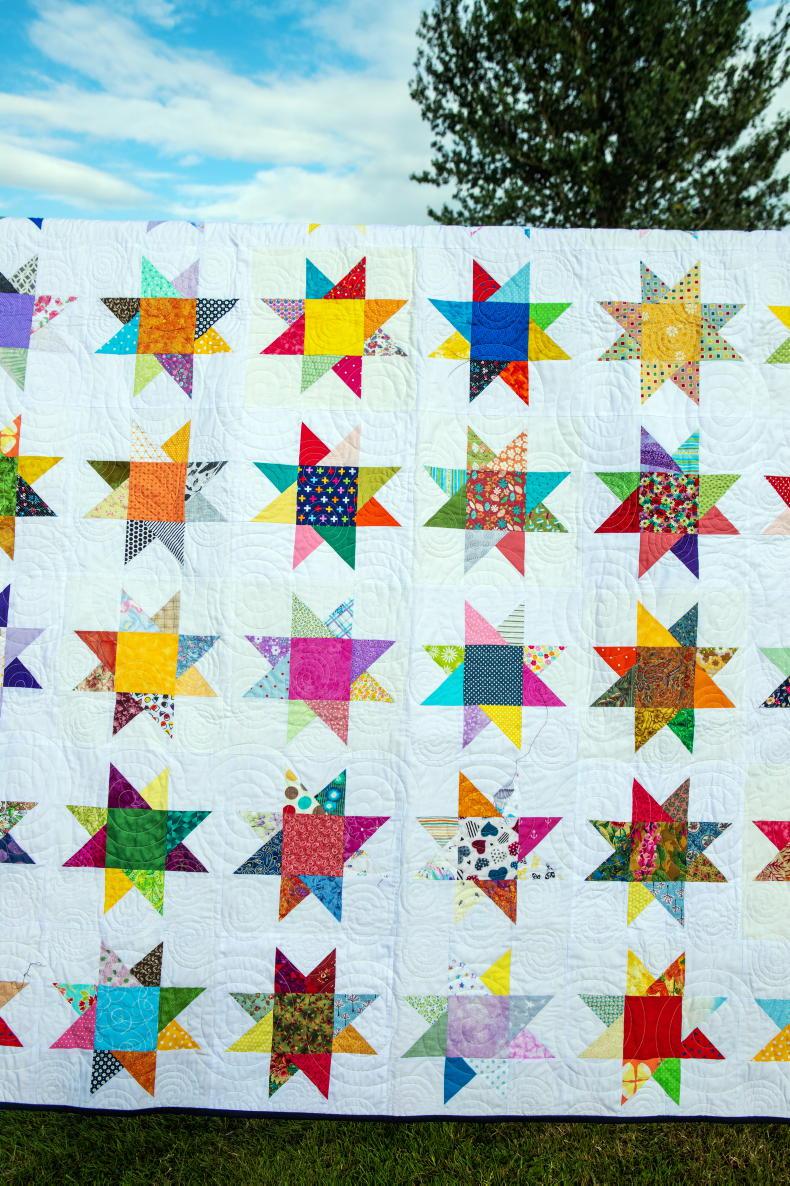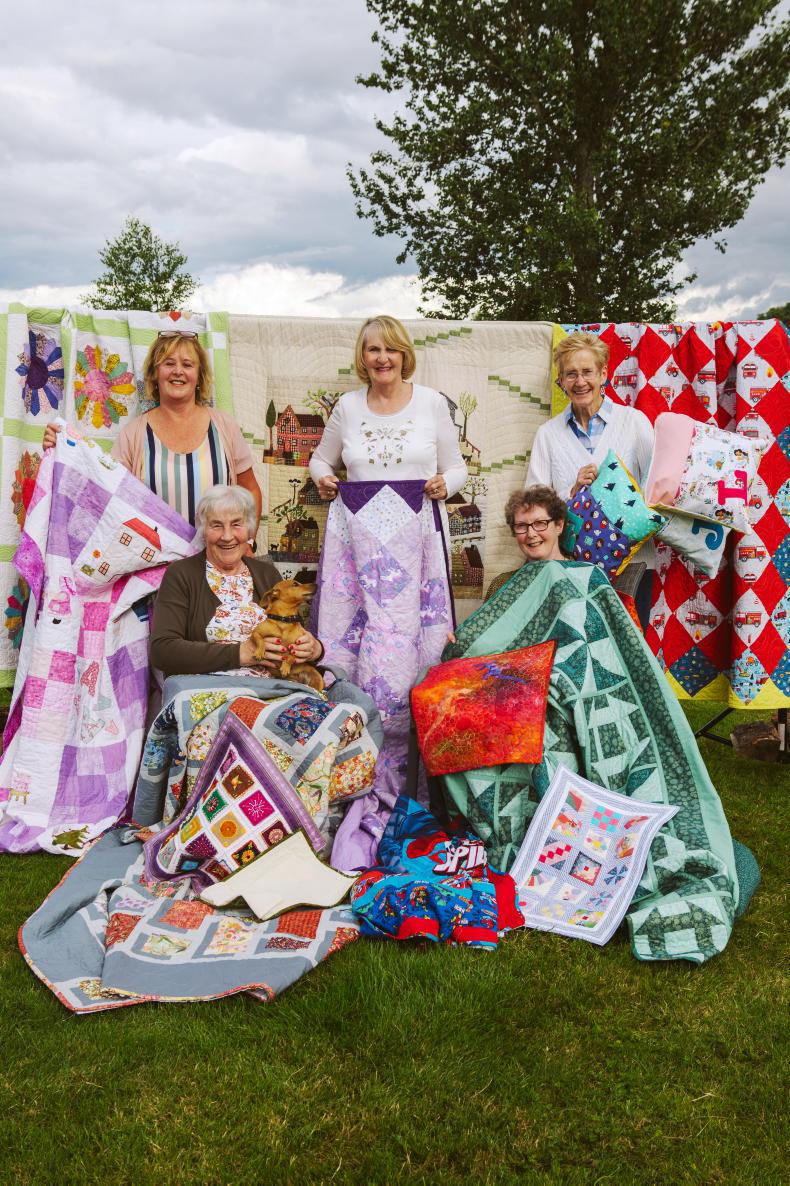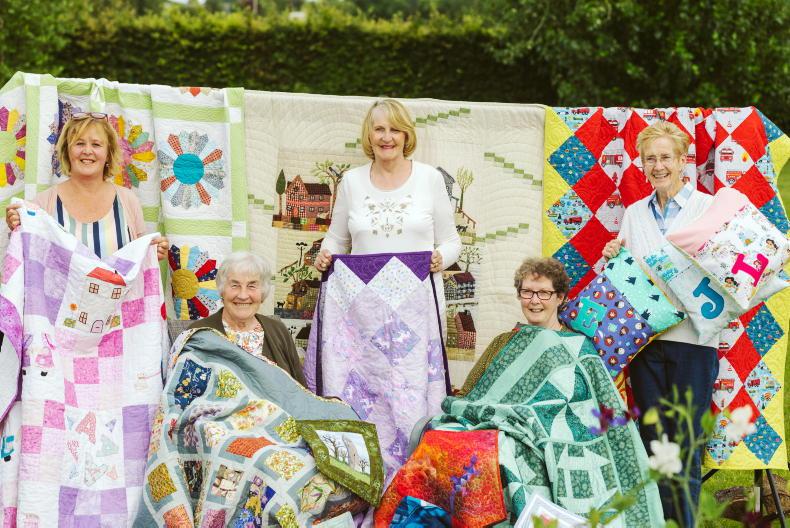Cottage industry definition: a small-scale, decentralised manufacturing business; generally operated out of a home (hence: cottage) and often producing labour-intensive products. These products usually face intense competition from large-scale manufacturers.
Patchwork is a craft which is close to my heart. Not because I have any skill in the craft whatsoever, but because I have pieces of patchwork full of my family’s heritage and hard work, which I treasure.
Anyone who appreciates patchwork – the art of piecing together different pieces of fabric, often in geometric patterns and, generally, with the intent of making a quilt – will also understand something of the heritage.

Using scraps of waste fabric to create something special, visually appealing and useful? The truth is, every quilt and piece of patchwork has a unique story to tell.
The Irish Patchwork Society are a proud bunch, and they should be. With nearly 350 active members and six branches throughout Ireland, they are celebrating their fortieth anniversary this year.
“We started in 1981 and now have six branches around the country – these are based in Dublin, Kilkenny, Cork, Limerick, Galway and Dundalk,” head of the national executive, Mary Hunter, says.
Born of necessity
Originally, patchwork wasn’t considered an art or a craft – it was a clever way of making use of whatever fabric one could find to keep themselves and their families warm. As time went on, style and pattern became more apparent.
“Historically, here (in Ireland) it’s linked to poverty,” Mary explains. “So quilts you might see within museums, at the moment, a lot of those would be made with off-cuts from shirt factories and that. Historically, it was the immigrants from Europe and here which brought it across to North America where it became [an affluent or decorative activity].”
The popularity of the Irish Patchwork Society proves quilting and patchwork are not lost or forgotten skills. That said, the amount of work which goes into making a quilt means you won’t find many people making a living from the art. Anne Marie Horan, who is based in Galway, says thanks largely to members of the society within local communities, this cottage industry is well protected.
“Quilting goes back thousands of years; they’ve found examples of it in the pyramids and the Japanese would use quilting to make their armour,” she explains.
“In Ireland, it’s now considered both a hobby and an art. With people like Miriam [Gogarty; based in Dublin] passing on skills and Margaret’s [McEvoy; based in Kilkenny] work – they do so much to keep the craft alive.”
Difficult to put a price on
The Irish Patchwork Society works within their local branches; providing education and community involvement through the art of quilting. As I speak with some of the members, the conversation moves to the monetary value of what they do.

“Well, I mean, if you were making a double bed quilt, how many hours would that take, would you say?” Anne Marie queries the group.
“Oh, a humongous amount of hours,” Mary responds.
“No one measures it in time, though,” adds Miriam.
Anne continues: “But, if you’re putting an economic value of it? If we were to make a quilt and sell it – we’re talking, say, 100 hours work, €200 worth of fabric, and charging, say, a tenner an hour (which is less than the minimum wage). This is why there is no one making quilts for money!”
The overall consensus of the group remains that, these days, those who work in patchwork and quilting do it with good will and intent in their heart. Quilts are largely made for loved ones and special occasions, and they are made for the enjoyment and pure artistry involved.
The Irish Patchwork Society are keeping busy this summer with some interesting exhibitions planned. From 7-28 July, Interchange Threads Connect will be taking place at the Phoenix Park Visitors’ Centre in Dublin. In Galway, Old Roots New Shoots will take place at Scoil Bhríde from 13-15 August. From 14-29 August, Landscape – Language – Migration (Teanga – Tírdhreach – Imirce) will take place at Pearse Cottage Museum in Rosmuc, Connemara, with patchwork and quilting demonstrations happening on 21-22 August (icpconamara.ie).
Finally, in conjunction with Northern Ireland Patchwork Guild, their exhibition Hanging Together Again: Hands Across the Border will take place at the An Táin Art Centre in Dundalk from 31 August to 4 September (antain.ie/gallery). Most of these events are free of charge.
irishpatchworksociety.wildapricot.org/

In honour of their 40th anniversary, the South Midlands Branch (from Kilkenny and the surrounding area) of the Irish Patchwork Society worked together throughout lockdown to create a commemorative quilt, which they called “You’re a Star”. They have decided to donate this quilt as a raffle prize to help raise funds for local charity Teac Tom (thethomashayestrust.com). This charity provides counselling, emergency response, and school and work liaison services for those affected by suicide and they currently receive no government funding.
The quilt is a double bed size (92”×104”) and made from 72 criss-cross star blocks designed by Lori Holt (beeinmybonnetco.blogspot.com). The branch members made 80 blocks in total, and so the remaining eight blocks were used to make eight cushions, which have also been donated to Teac Tom. Their goal is to raise €3,000 for the charity.
The quilt will be on display at the South Midlands Branch Irish Patchwork Society exhibition from 12-15 August at St Mary’s Cathedral in Kilkenny, with the draw taking place 9 September.
You can enter the raffle online:
idonate.ie/raffle/irishpatchworksociety
Read more
Irish tweed design: an element of heritage
Irish heritage lace: a delicate subject
Cottage industry definition: a small-scale, decentralised manufacturing business; generally operated out of a home (hence: cottage) and often producing labour-intensive products. These products usually face intense competition from large-scale manufacturers.
Patchwork is a craft which is close to my heart. Not because I have any skill in the craft whatsoever, but because I have pieces of patchwork full of my family’s heritage and hard work, which I treasure.
Anyone who appreciates patchwork – the art of piecing together different pieces of fabric, often in geometric patterns and, generally, with the intent of making a quilt – will also understand something of the heritage.

Using scraps of waste fabric to create something special, visually appealing and useful? The truth is, every quilt and piece of patchwork has a unique story to tell.
The Irish Patchwork Society are a proud bunch, and they should be. With nearly 350 active members and six branches throughout Ireland, they are celebrating their fortieth anniversary this year.
“We started in 1981 and now have six branches around the country – these are based in Dublin, Kilkenny, Cork, Limerick, Galway and Dundalk,” head of the national executive, Mary Hunter, says.
Born of necessity
Originally, patchwork wasn’t considered an art or a craft – it was a clever way of making use of whatever fabric one could find to keep themselves and their families warm. As time went on, style and pattern became more apparent.
“Historically, here (in Ireland) it’s linked to poverty,” Mary explains. “So quilts you might see within museums, at the moment, a lot of those would be made with off-cuts from shirt factories and that. Historically, it was the immigrants from Europe and here which brought it across to North America where it became [an affluent or decorative activity].”
The popularity of the Irish Patchwork Society proves quilting and patchwork are not lost or forgotten skills. That said, the amount of work which goes into making a quilt means you won’t find many people making a living from the art. Anne Marie Horan, who is based in Galway, says thanks largely to members of the society within local communities, this cottage industry is well protected.
“Quilting goes back thousands of years; they’ve found examples of it in the pyramids and the Japanese would use quilting to make their armour,” she explains.
“In Ireland, it’s now considered both a hobby and an art. With people like Miriam [Gogarty; based in Dublin] passing on skills and Margaret’s [McEvoy; based in Kilkenny] work – they do so much to keep the craft alive.”
Difficult to put a price on
The Irish Patchwork Society works within their local branches; providing education and community involvement through the art of quilting. As I speak with some of the members, the conversation moves to the monetary value of what they do.

“Well, I mean, if you were making a double bed quilt, how many hours would that take, would you say?” Anne Marie queries the group.
“Oh, a humongous amount of hours,” Mary responds.
“No one measures it in time, though,” adds Miriam.
Anne continues: “But, if you’re putting an economic value of it? If we were to make a quilt and sell it – we’re talking, say, 100 hours work, €200 worth of fabric, and charging, say, a tenner an hour (which is less than the minimum wage). This is why there is no one making quilts for money!”
The overall consensus of the group remains that, these days, those who work in patchwork and quilting do it with good will and intent in their heart. Quilts are largely made for loved ones and special occasions, and they are made for the enjoyment and pure artistry involved.
The Irish Patchwork Society are keeping busy this summer with some interesting exhibitions planned. From 7-28 July, Interchange Threads Connect will be taking place at the Phoenix Park Visitors’ Centre in Dublin. In Galway, Old Roots New Shoots will take place at Scoil Bhríde from 13-15 August. From 14-29 August, Landscape – Language – Migration (Teanga – Tírdhreach – Imirce) will take place at Pearse Cottage Museum in Rosmuc, Connemara, with patchwork and quilting demonstrations happening on 21-22 August (icpconamara.ie).
Finally, in conjunction with Northern Ireland Patchwork Guild, their exhibition Hanging Together Again: Hands Across the Border will take place at the An Táin Art Centre in Dundalk from 31 August to 4 September (antain.ie/gallery). Most of these events are free of charge.
irishpatchworksociety.wildapricot.org/

In honour of their 40th anniversary, the South Midlands Branch (from Kilkenny and the surrounding area) of the Irish Patchwork Society worked together throughout lockdown to create a commemorative quilt, which they called “You’re a Star”. They have decided to donate this quilt as a raffle prize to help raise funds for local charity Teac Tom (thethomashayestrust.com). This charity provides counselling, emergency response, and school and work liaison services for those affected by suicide and they currently receive no government funding.
The quilt is a double bed size (92”×104”) and made from 72 criss-cross star blocks designed by Lori Holt (beeinmybonnetco.blogspot.com). The branch members made 80 blocks in total, and so the remaining eight blocks were used to make eight cushions, which have also been donated to Teac Tom. Their goal is to raise €3,000 for the charity.
The quilt will be on display at the South Midlands Branch Irish Patchwork Society exhibition from 12-15 August at St Mary’s Cathedral in Kilkenny, with the draw taking place 9 September.
You can enter the raffle online:
idonate.ie/raffle/irishpatchworksociety
Read more
Irish tweed design: an element of heritage
Irish heritage lace: a delicate subject









 This is a subscriber-only article
This is a subscriber-only article









SHARING OPTIONS: